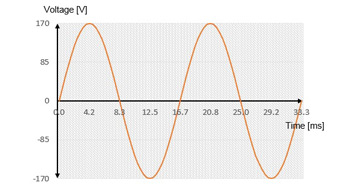
Used to deliver power to your home, office, and any other building you can think of, alternating current (AC) voltage is relied on to provide power flawlessly on a daily basis. But why isn’t direct current (DC) voltage, commonly found in most digital electronics, used in these settings?
Why do we use AC in our homes? Simply put, AC voltage is capable of converting voltage levels with just a transformer, making it far easier to transport across great distance than DC, whose conversion requires more complex electronic circuitry.
Electric charge in AC periodically changes direction, causing the voltage level to reverse. As a result, AC voltage needs to step up if transmitted over a large distance, but this does not affect the speed of the transition process. Such ease in conversion allows for AC also to appear in electric generators, motors, and power distribution systems. Requiring only a transformer to convert its voltage levels is perhaps the greatest advantage AC has over DC, as direct current may only create magnetic fields, preventing it from working with transformers at all.
However, at China’s Three Gorges Dam, DC transmission lines transport power to people with fewer losses of energy than AC, displaying that household use of DC power is becoming more conventional. Engineering company Siemens has even installed a 65-mile high-voltage direct current (HVDC) line that stretches from the Pennsylvania/New Jersey power grid to Long Island. Such projects could cause an unprecedentedly high usage of renewable energy. Still, while these higher DC voltages usually lead to riskier power deliveries and DC grids can be difficult to monitor, high AC voltages can be reduced to a safer level when they’re transmitted from a power station.

A concept’s ability to stay relevant traces back to its usability in everyday life, and AC power once claimed its place in homes with the fact that modern lighting worked more efficiently with AC. Incandescent lights may use either type of power, but fluorescent lights are optimized for AC. However, while electricity still runs primarily on AC power, DC powers LEDs and solar cells, raising a question of what may happen if eco-friendly lighting becomes even more desirable than it already is. Methods for converting direct current to higher and lower voltages have now been discovered, showing that the world is adapting itself to these potential changes.
While concerns for broader use of DC include accommodating devices with different voltages and experiencing leakage due to the presence of more components, some advantages are still evident. What are the advantages of DC? Apart from the wide usage of LEDs, DC power systems would ultimately lead to shrinking of power supplies and less wastage of energy. As more devices begin to use lower voltages, there is less need for power conversion. DC’s greatest current benefit remains to be its usage in low voltage and special applications, charging things like batteries and aircraft applications. It ultimately holds an advantage over AC-powered LED lights, all of which flicker, meaning a constant fluctuation of light output from on to off.
However, the world continues to opt for the simplest method of delivering power. AC voltage generates efficiently and has been continuously tested by time. As of now, not enough devices are attuned to working with DC voltage for it to become mainstream practice, and economic and practical results of switching fully to DC power are unpredictable. While DC voltage is gradually disproving its inefficiency in supplying power across wider distances, AC voltage still provides the easiest, most reliable electricity that allows people to go through their days easily.
Source: ExtremeTech, School for Champions, All About Circuits, Study.com, Sparkfun, Energy.gov, Chris Gammell’s Analog Life, Architectural Lighting, National Geographic
Related Articles:
AC/DC converters simplify buck converter designs for appliances
Advertisement
Learn more about Electronic Products Magazine





